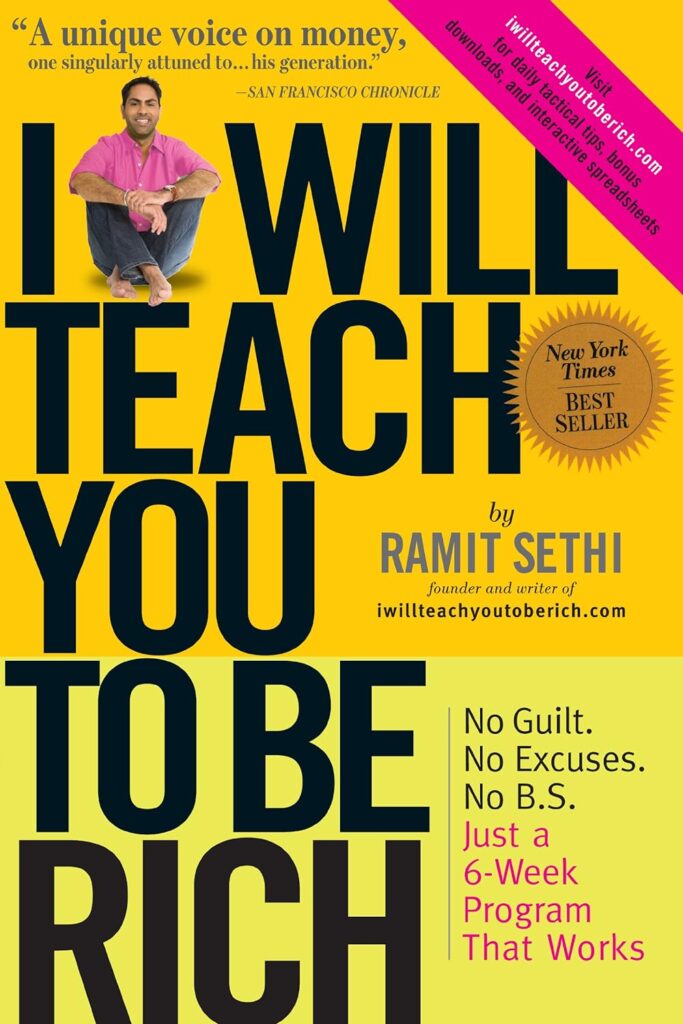You are not alone if the realm of personal finance has ever seemed overwhelming to you. It can be difficult to figure out where to begin, particularly with the abundance of contradicting guidance available. To that end, I Will Show You to Be Rich by Ramit Sethi is a best-selling book.
Sethi’s main goal is to assist you in being financially successful by helping you to cut through the clutter and offering a straightforward, effective 6-week approach.

I Will Teach You How to Become Rich is more than simply a standard financial manual; it holds that you may achieve your own “rich life” by recognizing and conquering your own “invisible scripts,” which are the ideas and lessons you’ve internalized from family and society.
SEE ALSO: 12 Methods for Being Productive Without Rushing
We’ll go through five practical takeaways from the book in this post. Your decision to add the book to your library or use the lessons as a tool for learning can be made with the aid of these resources.
Lesson 1: Making a Personal Budget
An outline of the actions Ramit Sethi recommends doing to draft a solid financial plan is provided in this section.
Beginning with…
The Program’s Six Weeks
A six-week approach to help you build wealth and improve your financial situation is offered in the book. The following steps make up this program:
1. First week: Recognizing your credit and using it to your advantage.
Open and maintain the appropriate bank accounts in week two to optimize savings.
3. Week 3: Develop your money by learning about retirement plans and investments.
Week 4: Make a deliberate spending strategy to control your out-of-pocket costs.
5. Week 5: Automat your accounts to cut down on time and prevent late penalties.
Week 6: Keep up your budget by making the required revisions and checking in on a regular basis.
Ramit’s main focus is on assessing your unique demands and creating a customized strategy that fits your budget during the program.
The Personal Finance Ladder
Ramit presents the idea of the “Ladder of Personal Finance” to assist you in setting priorities for your financial objectives and activities. There are five steps involved:
SEE ALSO: How to Get More Out of Life and Conquer Your Fear of the Unknown
1. Create a fund for emergencies: To protect yourself from unanticipated events, save aside at least a month’s worth of daily living costs in a savings account with a high rate of return.
2. Pay off high-interest debt: In order to prevent squandering money on escalating interest expenses, take care of any debts that remain with an interest rate greater than 5–7%.
3. Make retirement fund investments: To take advantage of tax benefits and long-term, compound gains, open an individual savings account (IRA) or make contributions to your employer-sponsored retirement savings scheme (401(k) or 403(b)).
1. Put money aside in an account for large expenses: Put money aside for anticipated costs such as family formation, a down payment on a home, or vacations.
2. Pay off low-interest debt: After completing the aforementioned tasks, make progress toward clearing any outstanding low-interest debt, including mortgages and student loans.
You can manage your money more wisely and build a strong financial base by using this ladder to guide you.
It is important to tailor your strategy to your own financial situation and objectives. Remember that attentive decision-making and consistent action are the keys to financial success as you go up the Staircase of Personal Finance during the six-week program.
SEE ALSO: The Psychology of Money by Morgan Housel Summary
Lesson 2: Make Cost Reductions and Save Money
To ensure that your money works for you, it is best to save and gradually cut back on your costs.
Ramit Sethi offers you some helpful ideas to consider in this vein.
The 85 % Solution
Around eighty-five percent of your personal financial strategy should be perfected, meaning you should save time and energy by not worrying about every little detail. You can now focus on other important parts of your path to prosperity.
To put this technique into practice, determine which expenses—such as rent, transportation, and food—account for the majority of your income. You can save a lot of money by streamlining these key costs and avoid wasting time on insignificant choices.
Savings on Major Purchases
In addition, Ramit discusses ways to save costs and negotiate for large purchases like a house, car, or even a wedding. To help you save even more money on these important expenses, consider the following advice:
1. Conduct thorough research: When it pertains to major purchases, information truly is power.
Examine costs, financing choices, and, if at all feasible, engage in negotiations with sellers. This will provide you with a strong basis on which to base your selections.
2. Bargain: When making large purchases, bargaining can help you save thousands of dollars.
Asking for better pricing shouldn’t be a fear because vendors frequently have wiggle room in their price. Be assertive and self-assured, but also courteous and polite.
SEE ALSO: The Million-Dollar One-Person Business: Book Summary
3. Take into account alternatives: Be open to considering different approaches to complete your buy. For instance, compared to buying a new car, buying a used one may save you a lot of money.
In a similar vein, looking into more affordable housing options or reducing wedding-related costs might result in significant savings.
on summary, you can successfully save money and reduce expenses on your financial journey by utilizing the 85 Percentage Solution and wise purchasing practices.
Lesson 3: Increasing Your Income
We’ll talk about a few of Sethi’s suggestions in this part for raising revenue.
While the book offers many helpful tips, two standout ones are “negotiating your salary” and “earning on the side.”
How to Bargain for Your Pay
Salary negotiating is one of the best strategies to increase your income. You should look at the market worth for the company and industry, suggests Ramit Sethi.
Payscale and Glassdoor are two websites that can assist you in gathering this data.
After you are aware of the range, put together a strong argument to make your employer see it.
• Recognize your accomplishments and special abilities that add value to the organization.
• Pay attention to how your efforts have helped the business or aided in its success.
• To build confidence, practice negotiating with an acquaintance or member of your family.
Refrain from taking the negotiation personally and instead concentrate on what you bring and the position’s market value.
Be prepared to make concessions, but keep in mind that over time, even a tiny raise can have a big impact on your income.
SEE ALSO: How Small Habits Can Reveal A Lot About Your Personality.
Making Extra Money
Examining side projects or part-time employment is another method to boost your income. Ramit Sethi advises using your abilities and interests to get extra revenue. Here are some suggestions to get you going:
• Working as a freelancer in your specialty (programming, graphic design, writing, etc.).
• Providing coaching or consulting services related to your line of work.
• Offering handcrafted or vintage goods for sale on websites such as eBay or Etsy.
• Offering online skill instruction via sites like Udemy or Skillshare.
It’s important to maintain a healthy balance between your primary employment and any side income you pursue. Allocate particular hours per week to concentrate on your side project, and monitor your advancement to make sure the work is worthwhile.
Lesson 4: Long-Term Investment Planning
It’s important to start with a fundamental understanding of investing in order to increase your money.
Recognize your invisible scripts.
To begin, acquaint yourself with ideas like invisible programs, which are fundamental financial attitudes that influence your choices frequently without your knowledge.
You can steer clear of typical traps and make well-informed decisions regarding your financial future by being aware of these scripts.
Study up on Compound Interest
The technique of generating interest on the two the original investment and any compounded interest over time is known as compound interest, and you will learn more about it next.
SEE ALSO: 7 Essential Ways to Love Yourself
This is the secret to long-term wealth growth. Your money has more time to compound and grow if you start investing early.
Learn the Distinction Between “Active” and “Passive” Investing
Furthermore, since the distinction between passive and active investing might have a big influence on your investing approach, it’s critical to comprehend it.
Buying and selling financial assets on a regular basis is known as active investing, whereas purchasing and keeping onto goods for a longer period of time is known as passive investing.
Finally, ensure that your portfolio is diversified. This entails making investments across a range of businesses and geographical areas and in a variety of asset classes. A portfolio that is well-diversified can increase your long-term growth potential and assist you in risk management.
Selecting the Appropriate Investments
Assessing the amount of risk you’re willing to take on in your approach to investing is the first step in determining your risk tolerance. If you are risk averse, for instance, you might prefer to concentrate on low-risk investments like index funds or bonds.
Think about your investing timeline next. To reduce the chance of losing the initial amount you invested, you might wish to choose more conservative options if you are making investments for short-term objectives.
Conversely, if your investment objectives are long-term, such as retiring, you are able to assume greater risk in exchange for the possibility of higher returns.
It’s also critical to assess the costs and track record of any investment you are thinking about. Remember that past results do not guarantee future performance, thus it is important to consider a range of criteria beyond past performance.
In conclusion, you should prioritize learning the fundamentals of investing while assembling your portfolio. You should also be aware of unseen factors that could sway your judgment and select the appropriate assets according to your risk tolerance, timeframe for investing, and individual financial objectives.
Watch this video if you want to reach significant financial goals for yourself:
Lesson 5: Understanding Debt and Credit
Ramit Sethi highlights how crucial it is to comprehend debt and credit management. You’ll position yourself for financial success by concentrating on raising your credit rating and making effective debt repayments.
Increasing Your Credit Rating
Take into account these pointers to raise your credit score:
SEE ALSO: 14 Best Solution For College Students To Save Money
1. Pay your bills on time: Your credit score is heavily influenced by timely payments. To prevent late payments, set up automatic payments or set reminders.
2. Maintain a low credit utilization ratio. This is the proportion of your available credit that you are utilizing. To demonstrate appropriate credit management, try to maintain it below 30%.
1. Check your credit score often. By keeping an eye on your credit report, you can identify errors and take quick corrective action.
2. Refrain from opening numerous accounts too quickly: Applying for a lot of credit accounts at once will bring down your credit score. As far as possible, avoid making new credit inquiries.
3. Keep a variety of accounts: Financial institutions can see that you can responsibly manage a range of credit types by seeing that you have a good mix of credit accounts, including loans with payments and revolving credit.
Debt Repayment
Another essential component of controlling your financial condition is paying off debt. Think about taking these actions:
1. Create a list of all of your outstanding bills, including the total amount owed, the interest rate, and the minimum payment.
2. Make your debts a priority: Prioritize paying off debt with high interest rates while keeping up with the minimum amounts on other debts.
3. Establish a spending plan: Calculate the monthly amount that you can afford to put toward your debts.
4. Apply the debt avalanche or snowball technique: The debt avalanche strategy concentrates on paying off high-interest debt first, while the debt snowball approach pays off smaller bills first to gain momentum. Select the approach that gives you the most motivation.
5. Take into account debt consolidation or refinancing: Your interest rates may drop as a result, and your debt may become easier to handle.
By working hard to pay off your bills and raise your credit score, you’re laying the groundwork for a better financial future.
Concluding Remarks about “I Will Show You to Be Rich“
Many insightful insights about accumulating, preserving, and expanding wealth can be learned from Ramit Sethi. A plethora of helpful information exist regarding overcoming wealth-related psychological hurdles (which we haven’t covered here).
The book also offers pointers on how to bargain for better prices and save money on regular expenses. These pointers have the potential to significantly affect your spending and create avenues for you to pursue your dream of living a “rich life.”






